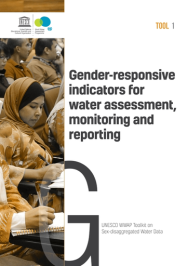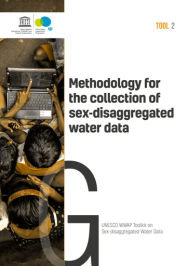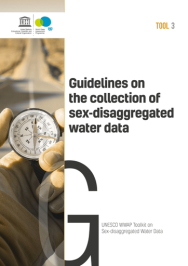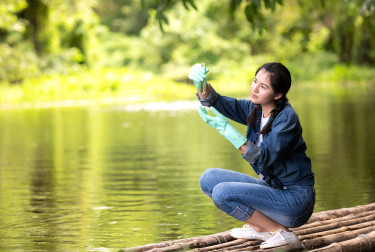
Addressing gender inequality in the water sector
In line with UNESCO's Gender Equality Priority, WWAP is launching a wide-ranging Call to Action to "Increase Gender Equality in the Water Sector: Filling Data Gaps and Implementing Concrete Actions" to bring together a multi-stakeholder coalition of Member State institutions, UN agencies, international and regional organizations, Official Development Assistance (ODA) agencies and civil society.
Good data is a prerequisite for achieving gender equality
Gender defines the roles, responsibilities and opportunities of people in society, and very often determines the potential they can achieve. Thus, women and men have different knowledge, talents, opportunities and needs. Gender also determines a person's relationship with water, as it determines the needs, access, use, and benefits associated with this vital resource.
When disaggregated data is collected, these differences become evident. Collecting water data disaggregated by sex, age, and other dimensions is a critical step in better understanding how water is used, managed, and distributed. Therefore, conducting gender analyses allows us to identify and understand gender issues, and how to adequately address them in planning, projects, and policies.
Good data and gender analysis are essential to achieving the ultimate goal of gender equality: that all people are on equal terms to use their human rights and to contribute to and benefit from economic, social, cultural and political development. Unfortunately, there are still significant gaps in sex-disaggregated data for water statistics at all levels.
Within the framework of UNESCO's Priority Gender Equality Action Plan, UNESCO WWAP is working on "Water and Gender Equality" along four axes:
- Indicators, methodology and tools on water and gender
- Capacity building
- Field projects
- Communication and advocacy
Methodology, indicators and tools
To address the lack of sex-disaggregated water data and provide scientific evidence on gender inequalities in water, UNESCO-WWAP has been working to create water and gender indicators, a reference methodology, and practical techniques and tools for collecting and analyzing disaggregated data in the field.
The aforementioned tools are integrated into the UNESCO-WWAP Gender Disaggregated Water Data Toolkit (first edition published in 2015, second edition published in 2019).
Tools for collecting gender-disaggregated water data
Member States' endorsement of the creation of a toolkit in 2015 (Tool 1) led to the development of a revised and more comprehensive second edition, published in 2019. The second edition takes into account lessons learned from field testing of the WWAP methodology and, most importantly, has been redesigned to incorporate SDG 6 and its targets as well as its linkages to gender equality and women's empowerment (SDG 5), as well as to the other Sustainable Development Goals of the 2030 Agenda.
All 4 tools are designed to help collect relevant quantitative and qualitative data on water and gender, useful to inform water policy and planning. They aim to help decision makers adopt data-driven and gender-transformative water policies and make concrete changes to advance gender equality in water and meet the 2030 Agenda for Sustainable Development. They include gender-sensitive indicators on: water governance; WASH; knowledge resources; transboundary water management; water for agriculture; water for industry and business; human rights-based water resources management; water, migration, displacement and climate change; indigenous knowledge and community water rights; and water education and training.
(Tool 1)
Features 105 gender-responsive indicators in 10 priority topics aligned with the 2030 Agenda.

(Tool 2)
Describes the methodological approaches and concepts collecting good quality data.

(Tool 3)
Covers data collection methods for different users and different geographic regions.

(Tool 4)
Lists 364 questions with instructions for developing surveys and interviews to collect qualitative and quantitative data in the field.


Capacity building
One of the spear point objectives of UNESCO WWAP is to help overcome the gap in gender data and set the basis to advance gender equality and women’s empowerment in the water sector. The WWAP methodology on the collection of sex-disaggregated water data with its own gender-responsive indicators (UNESCO WWAP 2019 Toolkit) is a unique resource that sets a global standard for gender responsive/transformative water monitoring and assessment. WWAP supports its application through a dedicated Capacity Development Programme.
Training
WWAP offers training activities tailored to the specific requirements of countries and regions, and fit to the needs a wide range of users (governmental staff, policy-makers, researchers, students, non-governmental entities, regional organizations including river basins and transboundary commissions, and community organizations). The training duration may vary according to the needs of the recipient, from the recommended 5 days for the complete training course, an introductory version of 2 days, or extended “on-demand” trainings. The trainings are designed to be delivered in both face-to-face and virtual formats.
Content
The WWAP capacity development programme is based on modular content, thereby covering a wide range of topics that gradually advances in terms of difficulty. It equips trainees with the conceptual basis of gender in the water realm, instructs them on the WWAP tools for the collection and analysis of disaggregated, good quality water data, and importantly, provides the foundation for carrying out contextualised gender analyses and effective integration of gender into the water sector.
Examples of training topics include:
- Understanding water and gender to achieve the 2030 Agenda
- Sex-disaggregated water data: why are they crucial?
- Gender-responsive water assessment, monitoring and reporting
- From theory to practice: how to develop a water and gender survey
- Linking data to comparable information: the use of water and gender indicators
- From sex-disaggregated water data to evidence-based policies
- From policy to action: gender-transformative water policies and programming
Skill aquirement
The training programme can provide trainees with specific tools and skills to:
- Understand gender integration concepts, sex-disaggregated water data and indicators;
- Autonomously conduct gender surveys and interviews on water-related topics;
- Acquire the skills to record and analyse raw data;
- Be capable of integrating a gender component into water projects and programmes;
- Be able to use reliable evidence in the policy-making process in order to make policies gender-responsive/transformative;
- Disseminate the acquired knowledge with colleagues, leaders, students and other relevant persons.
Special focus goes to the interlinkages among the 17 Sustainable Development Goals (SDG), in particular SDG 5 (gender equality and the empowerment of women and girls) and SDG 6 (water and sanitation) in their intersections with the other SDGs.

Projects
WWAP has extensive experience in water and gender project implementation in which it is responsible and/or advisor for the mainstreaming of gender-responsive water monitoring, assessment and reporting. WWAP also contributes with expertise in the application and dissemination of sex-disaggregated indicators.
WWAP relies on a solid and tested methodological approach to effectively include consideration of gender equality, women’s empowerment, and inclusive governance to project proposals and implementation, water management planning and donor’s waters portfolio for an improved (integrated) management of freshwater resources, including in transboundary contexts.
Communication and advocacy
WWAP’s efforts are centred on:
- Mobilising decision-makers and governments to accelerate gender equality and the empowerment of women and girls in the water sector through concrete and bold actions.
- Raising awareness on the need for collecting sex-disaggregated water data and enhancing knowledge of project managers and partners on the topic.
- Providing guidance on gender integration and gender mainstreaming in practice.
- Informing a wide range of stakeholders on WWAP’s activities and publications with respect to water and gender, and a broad spectrum of interlinked development topics.
WWAP is an active actor in the organization of workshops at international events such as the World Water Week (WWW), International Water Council (IWC), Commission on the Status of Women (CSW) and a multitude of other conferences and meetings. Regional and national advocacy events also form part of WWAP’s field of action, to ensure the incorporation of a regional component in its strategy, and collaborate with regional actors.
WWAP facilitates a coordinated Call for Action to accelerate the achievement of gender equality in the water domain, together with a multi-stakeholder coalition composed by UN agencies, international and regional organizations, NGOs, ODAs, Member States institutions, private sector and civil society.
In order to support the aforementioned efforts, and to communicate its messages in the broadest way possible to the general public, WWAP is also present on social media and can be followed on Twitter through @UNESCOWWAP



